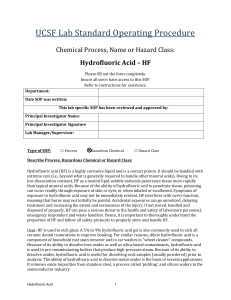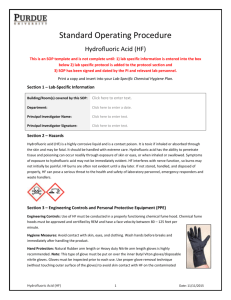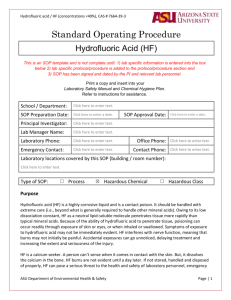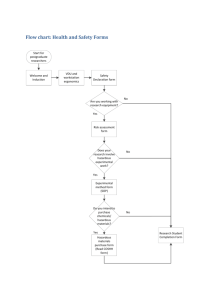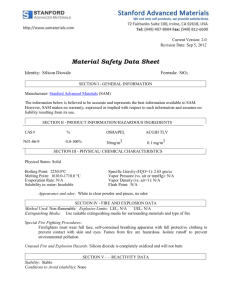uci-hydrofluoric-acid_final-draft_leo-ehs-edit
advertisement
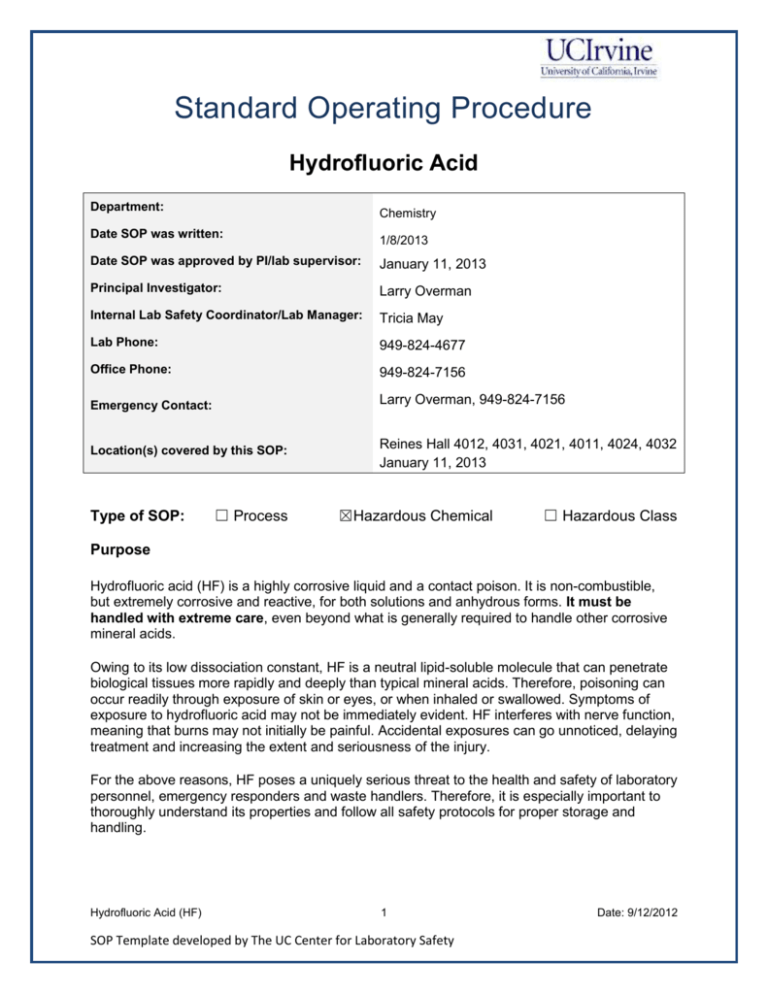
Standard Operating Procedure Hydrofluoric Acid Department: Chemistry Date SOP was written: 1/8/2013 Date SOP was approved by PI/lab supervisor: January 11, 2013 Principal Investigator: Larry Overman Internal Lab Safety Coordinator/Lab Manager: Tricia May Lab Phone: 949-824-4677 Office Phone: 949-824-7156 Emergency Contact: Larry Overman, 949-824-7156 Location(s) covered by this SOP: Reines Hall 4012, 4031, 4021, 4011, 4024, 4032 January 11, 2013 Type of SOP: ☐ Process ☒Hazardous Chemical ☐ Hazardous Class Purpose Hydrofluoric acid (HF) is a highly corrosive liquid and a contact poison. It is non-combustible, but extremely corrosive and reactive, for both solutions and anhydrous forms. It must be handled with extreme care, even beyond what is generally required to handle other corrosive mineral acids. Owing to its low dissociation constant, HF is a neutral lipid-soluble molecule that can penetrate biological tissues more rapidly and deeply than typical mineral acids. Therefore, poisoning can occur readily through exposure of skin or eyes, or when inhaled or swallowed. Symptoms of exposure to hydrofluoric acid may not be immediately evident. HF interferes with nerve function, meaning that burns may not initially be painful. Accidental exposures can go unnoticed, delaying treatment and increasing the extent and seriousness of the injury. For the above reasons, HF poses a uniquely serious threat to the health and safety of laboratory personnel, emergency responders and waste handlers. Therefore, it is especially important to thoroughly understand its properties and follow all safety protocols for proper storage and handling. Hydrofluoric Acid (HF) 1 SOP Template developed by The UC Center for Laboratory Safety Date: 9/12/2012 Physical & Chemical Properties/Definition of Chemical Group CAS#: 7664-39-3 Class: Acutely toxic & Corrosive Molecular Formula: HF Form (physical state): Liquid (anhydrous) Color: Colorless, fuming Boiling point: 19o C (67o F) Potential Hazards/Toxicity Target Organs - Liver, Kidney, Nerves, Respiratory system, Bone Potential Acute and Chronic Health Effects General: Repeated, prolonged overexposure to inorganic fluoride compounds, including HF, may result in gastrointestinal disturbances, loss of weight, anemia (reduced number of red blood cells), diseases of the teeth, and skeletal fluorosis. Skeletal fluorosis is characterized by bone and joint pain, limited motion in the joints or spine, increased bone density that can cause the bones to become brittle, and hardening of the ligaments. Overexposure to this material or its components has been suggested as a cause of the following effects in laboratory animals: nervous system effects, blood and liver abnormalities, and kidney damage. Inhalation Toxic if inhaled. Material is extremely destructive to the tissue of the mucous membranes and upper respiratory tract. Skin May be fatal if absorbed through skin. Causes skin burns. Eyes Causes severe eye burns. Ingestion May be fatal if swallowed. OCCUPATIONAL EXPOSURE LIMITS: OSHA PEL: TWA 3 ppm NIOSH REL: TWA 3 ppm (2.5 mg/m3); C 6 ppm (5 mg/m3) 15-minute NIOSH IDLH: 30 ppm TLV: (as F) 0.5 ppm; as TWA, 2 ppm (Ceiling value) Personal Protective Equipment (PPE) Respiratory Protection Respirators should be used only under any of the following circumstances: Hydrofluoric Acid (HF) 2 SOP Template developed by The UC Center for Laboratory Safety Date: 9/12/2012 As a last line of defense (i.e., after engineering and administrative controls have been exhausted). When the Permissible Exposure Limit (PEL) has been exceeded or when there is a possibility that PEL will be exceeded. Regulations require the use of a respirator. An employer requires the use of a respirator. There is potential for harmful exposure due to an atmospheric contaminant (in the absence of PEL). As PPE in the event of a chemical spill clean-up process Lab personnel intending to use/wear a respirator mask must be trained and fit-tested by EH&S. This is a regulatory requirement. If you think that your process may require respirator use, contact EH&S for assistance (http://www.ehs.uci.edu/programs/ih/respiratory.html) Where such risk assessment shows air-purifying respirators are appropriate, use a full-face respirator with multi-purpose combination (US) or type ABEK (EN 14387) respirator cartridges as a backup to engineering controls. If the respirator is the sole means of protection, use a fullface supplied air respirator. Use respirators and components tested and approved under appropriate government standards such as NIOSH (US) or CEN (EU). Hand Protection Two layers of gloves are highly recommended for adequate protection. Natural Heavy Duty Butyl Rubber or Heavy Duty Nitrile arm length gloves are highly recommended for outerwear. Note: This type of glove must be donned over inner Butyl Viton or disposable nitrile gloves. Gloves must be inspected prior to each use. Use proper glove removal technique (without touching outer surface of the gloves) to avoid skin contact with HF on the contaminated gloves. Dispose of inner nitrile gloves after use as hazardous waste. The inner Butyl Viton gloves can be reused carefully (i.e., without touching the outer surface of the gloves) if they have been deemed uncontaminated following inspection. Wash hands thoroughly with warm water and soap afterwards. NOTE: Consult with your preferred glove manufacturer to ensure that the gloves you plan on using are compatible with Hydrofluoric acid. Refer to glove selection chart from the links below: http://www.ansellpro.com/download/Ansell_8thEditionChemicalResistanceGuide.pdf ; or http://www.allsafetyproducts.biz/page/74172 ; or http://www.showabestglove.com/site/default.aspx ; or Hydrofluoric Acid (HF) 3 SOP Template developed by The UC Center for Laboratory Safety Date: 9/12/2012 http://www.mapaglove.com/ Eye Protection Tightly fitting safety goggles & face shield (8-inch minimum, ANSI approved). Skin and Body Protection Lab coat & natural rubber apron Full-length pants Closed-toe rubber or leather shoes NOTE: If HF is used in a cleanroom, the cleanroom gown will substitute for lab coat and full length pants. In addition, all the other PPE listed in this section is applicable. Hygiene Measures Avoid contact with skin, eyes and clothing. Handle in accordance with good industrial hygiene and safety practices. Wash potentially exposed areas thoroughly and immediately after handling. Wash hands before breaks and at the end of workday. Remove contaminated clothing and wash before reuse. Additional PPE may be required if procedures or processes present additional risk. It is the responsibility of the PI to ensure that any additional PPE requirements are identified and communicated to research staff. Engineering Controls To be used on annually certified chemical fume hood. The following is a general plan for hydrofluoric acid and all strong corrosives in general: 1. All work must be done in a certified chemical fume hood when possible, unless other controls are designated in the Protocol/Procedure section. Sash height should be kept low to avoid escaping fumes and provide a physical barrier. 2. Transport these materials between locations using a bottle carrier whenever possible. 3. Chemical dispensers are a very good way to reduce potential exposures. First Aid Procedures General advice Calcium gluconate gel should be available and within immediate reach prior to handling hydrofluoric acid or its solutions. Hydrofluoric (HF) acid burns require immediate and specialized first aid and medical treatment. Symptoms may be delayed up to 24 hours depending on the concentration of HF. After decontamination with water, further damage can occur due to penetration/absorption of the fluoride ion. Treatment should be directed toward Hydrofluoric Acid (HF) 4 SOP Template developed by The UC Center for Laboratory Safety Date: 9/12/2012 binding the fluoride ion as well as the effects of exposure. Skin exposures can be treated with a 2.5% calcium gluconate gel, repeated until burning ceases. More serious skin exposures may require subcutaneous calcium gluconate except for digital areas unless the physician is experienced in this technique, due to the potential for tissue injury from increased pressure. Absorption can readily occur through the subungual areas and should be considered when undergoing decontamination. Prevention of absorption of the fluoride ion in cases of ingestion may be achieved by giving milk, chewable calcium carbonate tablets or Milk of Magnesia to conscious victims. Conditions such as hypocalcaemia, hypomagnesaemia and cardiac arrhythmias should be monitored for, since they can occur after exposure. Consult a physician. Show this safety data sheet to the doctor in attendance. Move out of dangerous area. NOTE: Calcium gluconate gel can be prepared by mixing a 10 mL ampoule of calcium gluconate with a 2-ounce tube of K-Y jelly (Johnson & Johnson). After this mixture has been opened and used, it should be discarded to prevent bacterial or chemical contamination. For pre-formulated commercial products, be sure to check the expiration date on the container(s) prior to use or storage. If inhaled If breathed in, move person into fresh air. If not breathing, give artificial respiration. Consult a physician. In case of skin contact Take off contaminated clothing and shoes immediately. Wash off with soap and plenty of water. Take victim immediately to hospital. Consult a physician. In case of eye contact Rinse thoroughly with plenty of water for at least 15 minutes and consult a physician. Continue rinsing eyes during transport to hospital. If swallowed Do NOT induce vomiting. Never give anything by mouth to an unconscious person. Rinse mouth with water. Consult a physician. Special Storage & Handling Requirements Ensure that you have all the PPE required for handling HF. HF must always be stored in plastic (Nalgene, Polypropylene, or Teflon) containers. DO NOT store HF in glass bottles/containers. Store in corrosive/acid storage cabinet within a secondary containment (Nalgene/ Polypropylene tray or tub). Do not store in the top most shelf of the storage cabinet. Note: In general, do not store chemicals at or above eye level. Ensure the container is tightly closed at all times. Hydrofluoric Acid (HF) 5 SOP Template developed by The UC Center for Laboratory Safety Date: 9/12/2012 Do not store with oxides, organic chemicals, bases or metals. Carefully carry the stock bottle in a Rubbermaid bottle carrier/nalgene secondary container to the wet bench/chemical fume hood and pour out desired amount into a smaller container. Place stock bottle back in corrosive chemical storage cabinet with cap tightly closed. Lab buddy system is highly recommended when handling HF. Lab emergency contact information must be readily available. The lab personnel must have easy access to a telephone (landline or cell phone). Spill and Accident Procedure Additional resources: Medical treatment poster at http://www.ehs.uci.edu/MedEmergPoster.pdf Online incident report at https://www.ehs.uci.edu/apps/hr/index.jsp General Guidelines: Personal precautions Wear respiratory protection. Avoid breathing vapors, mist or gas. Ensure adequate ventilation. Evacuate personnel to safe areas. Environmental precautions Prevent further leakage or spillage if safe to do so. Do not let product enter drains. Methods and materials for containment and cleaning up Soak up with inert absorbent material and dispose of as hazardous waste. Keep in suitable, closed containers for disposal. Personal Protective equipment must be worn – natural rubber gloves (arm length), goggles, face shield, natural rubber apron/suit, long pants, closed-toe rubber/leather shoes, respirator approved for HF handling. Immediately assess amount spilled. Contact Environment Health & Safety (EH&S) and dial 911 from a campus phone. Cover the contaminated surface with a neutralizing agent (sodium carbonate, bicarbonate, or a soda ash/flaked lime mixture, 50/50). Mix and add water if necessary to form a slurry and wash site with soda ash solution. Proper mixing procedures are essential and only trained personnel should conduct this procedure. Untrained personnel should be removed from the spill area. Hydrofluoric Acid (HF) 6 SOP Template developed by The UC Center for Laboratory Safety Date: 9/12/2012 Pick up contaminated material with a disposable scoop and place in a double transparent plastic bag. Label and tag as hazardous waste and bring to hazardous waste pick up. Chemical Spill: Call 911 from a campus phone or call EH&S. Medical Emergency Dial 911 Life Threatening Emergency, After Hours, Weekends and Holidays – Dial 911 or go to the nearest emergency room.) Note: All Serious injuries must be reported to EH&S within 8 hours. Non-Life Threatening Emergency – Go to the Occupational Health Facility (OHF). After hours, go to the nearest emergency room. Note: All serious injuries must be reported to EH&S within 8 hours. Needle stick/puncture exposure (as applicable to chemical handling procedure) – Wash the affected area with antiseptic soap and warm water for 15 minutes. For mucous membrane exposure, flush the affected area for 15 minutes using an eyewash station. Page the needle stick nurse and then enter your extension. After hours, go to the nearest emergency room. Note: All needle stick/puncture exposures must be reported to EH&S within 8 hours. ALL WORK RELATED INJURIES MUST BE REPORTED via the On-line Incident Form https://www.ehs.uci.edu/apps/hr/index.jsp or call Human Resources, Workers Compensation (949) 824-9152. Decontamination/Waste Disposal Procedure General guidelines are located at http://www.ehs.uci.edu/programs/enviro/ Work area: Hydrofluoric acid spills should immediately be reported to EH&S. The spills are usually cleaned by using sodium carbonate or equivalent (see above). Only trained personnel should conduct this procedure. All surfaces should be wiped with the appropriate cleaning agent following dispensing or handling. Waste materials generated should be treated as hazardous waste. After each use, wipe down the immediate work area and equipment to prevent accumulation of chemical residue and thoroughly decontaminate the designated area before resuming normal laboratory work in the area. Equipment: Decontaminate vacuum pumps or other equipment (glassware) before removing them from the designated area. Personnel: Upon leaving the designated area, remove any personal protective equipment worn and wash hands, forearms, face, and neck. Immediately after working with hydrofluoric acid, remove gloves and wash hands and arms with soap and water. HF is listed as an Extremely Hazardous (EH) Substance by the State of California. Even the containers (irrespective of the size) which once held HF must be disposed of as hazardous waste with an on-line hazardous waste tag affixed on the container. Hydrofluoric Acid (HF) 7 SOP Template developed by The UC Center for Laboratory Safety Date: 9/12/2012 Even the safety gloves that come in contact with HF (i.e., HF contaminated gloves) must be disposed of as dry hazardous waste. All dry hazardous waste must be double bagged (use only transparent bags) and affixed with an on-line waste tag. Label Waste Hazardous waste labels must be placed on the hazardous waste container upon the start of accumulation. Labels are available online at www.ehs.uci.edu/programs/enviro/. Store Waste Hazardous waste containers must be kept closed, except when adding waste. Hazardous waste containers must be stored in secondary containment to adequately contain all of the contents of the container. Hazardous waste containers must be inspected weekly for signs of leaks, corrosion, or deterioration. Dispose of Waste Hazardous waste must be transferred to EH&S for disposal within 6 months of being generated. Hazardous Waste Disposal: o Visit www.ehs.uci.edu/programs/enviro/. o Fill out the “Chemical Waste Collection” form. o EH&S will pick up your waste within 1-3 days. Do not dispose of chemicals by pouring them down the drain or placing them in the trash. Do not use fume hoods to evaporate chemicals. Empty Containers: At no time should full or partially full containers be placed in the trash. As mentioned above, even empty containers that once held HF must be treated as hazardous waste with an on-line hazardous waste tag affixed on the container. For more information on empty container management visit http://www.ehs.uci.edu/programs/enviro/ Safety Data Sheet (SDS) Location Online SDS can be accessed at http://www.ehs.uci.edu/msds.html Designated Area Designated laboratory for handling and manipulation of hydrofluoric acid: Reines Hall, room 4012. Prior Approval Required Hydrofluoric Acid (HF) 8 SOP Template developed by The UC Center for Laboratory Safety Date: 9/12/2012 The use of hydrofluoric acid (even small quantities) should be approved by Prof. Overman prior to use. Protocol/Procedure and Lab Specific Details: Additional precautions apply to all particularly hazardous substance (adapted from Prudent Practices in the Laboratory: Handling and Management of Chemical Hazards The National Academies Press: Washington, DC, 2011). 1. PLAN carefully and think ahead. You must have an understanding of the intrinsic hazards of the substances being used or potentially formed in any reaction. NEVER work with a reagent you are unfamiliar with without consulting Prof. Overman or an experienced co-worker and relevant SDS information, toxicological data, or other safety information. Always consider substituting less dangerous substances for hazardous materials and using only the smallest amount possible. For substances with unusual potential hazards, consult A Comprehensive Guide to the Hazardous Properties of Chemical Substances (Patanik, 2007) or the NIOSH website (http://www.cdc.gov/niosh/). Plan for careful management of the substances through their life cycle—from acquisition and storage through safe disposal. Choose equipment and glassware that are easy to clean and decontaminate. You must also know the signs and symptoms of acute exposure, and know how to respond in an emergency Note: The combination of the hazardous effects of two substances may be significantly greater than the toxic effect of either substance alone. Additionally, the possibility of generating toxic reaction products must also be considered during the planning phase. 2. Never work alone. It is essential that more than one person be present in the lab at all times, but especially when particularly hazarous materials, like hydrofluoric acid, are handled. Additionally, it is your responsibility to be sure that all individuals working in the vicinity are familiar with the hazards of the experiments that you are conducting as well as the appropriate emergency responses. 3. Confine procedures involving particularly hazardous substances that can generate dust, vapors, or aerosols to a chemical hood, glovebox, or other containment device. Procedures such as transfers to reaction vessels should be confined to a designated work area (e.g. fume hood). This area should be recognized as a place where special training/precautions/skill are required. When toxic chemicals are used in a chemical hood, the sash should be at a proper level. When working in a glove box, it should be operated under negative pressure. Post signs to alert others of particularly dangerous experiments. 4. Wear gloves and safety glasses for protection. Select gloves to make sure they are impervious to the chemical being used and correct thickness (see above guidelines and recommendations). Consult Prudent Practices (link above) if you are unsure. Check gloves for integrity and appropriate composition before use. Safety glasses with side shields are a minimum standard. In some cases, face shields or respirators may be required. 5. Isolate equipment, including vacuum pumps and rotovaps, for handling of particularly hazardous chemicals. 6. Practice good hygiene. Cleanliness, order and good housekeeping practices create an intrinsically safer workplace. After using a particularly hazardous material like hydrofluoric acid, wash hands/neck/arms/face with soap and water. Equipment that might be contaminated (including gloves) must not be removed from the area reserved for handling particularly hazardous materials without complete decontamination. In the case of hydrofluoric Hydrofluoric Acid (HF) 9 SOP Template developed by The UC Center for Laboratory Safety Date: 9/12/2012 acid, contaminated gloves should be treated as solid hazardous waste and treated accordingly. Wipe down the immediate work area and equipment to prevent accumulation of chemical residue and thoroughly decontaminate the designated area before resuming normal laboratory work in the area. Several reactions have their own SOP which you should consult. They are located in our Safety on Site binder. NOTE Any deviation from this SOP requires approval from PI. Documentation of Training (signature of all users is required) Prior to conducting any work with Hydrofluoric Acid (HF), designated personnel must provide training to his/her laboratory personnel specific to the hazards involved in working with this substance, work area decontamination, and emergency procedures. The Principal Investigator must provide his/her laboratory personnel with a copy of this SOP and a copy of the SDS provided by the manufacturer. The Principal Investigator must ensure that his/her laboratory personnel have attended appropriate laboratory safety training or refresher training within the last one year. Hydrofluoric Acid (HF) 10 SOP Template developed by The UC Center for Laboratory Safety Date: 9/12/2012 I have read and understand the content of this SOP: Name Signature Identification Date . . . Hydrofluoric Acid (HF) 11 SOP Template developed by The UC Center for Laboratory Safety Date: 9/12/2012
